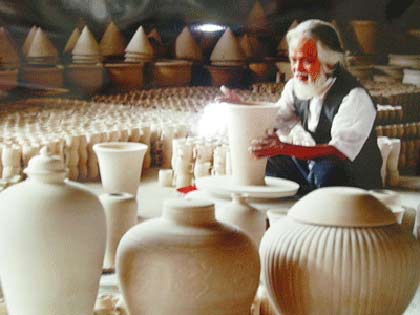Hanoi's People's Committee issued Program 154/UBND-CT on developing tourism associated with craft villages for the 2012-2015 period, with the aim of creating favorable conditions for craft villages in the capital to promote their strengths.
 With 1,350 craft villages, including 244 traditional villages, Hanoi is the country's largest home for craft villages. Hanoi's traditional craft villages are particularly attractive for international and domestic traveler, including Bat Trang Ceramic Village, Van Phuc Silk Village, Ha Thai Lacquer Village, Son Dong Wood Carving Village, and Chuyen My Mosaic Village. Visiting these craft villages, visitors will not just be interested in shopping, but also in direct contact with artisans and participating in their work. Therefore, these villages are indispensable destinations in the City's tour for many tourists in recent years.
With 1,350 craft villages, including 244 traditional villages, Hanoi is the country's largest home for craft villages. Hanoi's traditional craft villages are particularly attractive for international and domestic traveler, including Bat Trang Ceramic Village, Van Phuc Silk Village, Ha Thai Lacquer Village, Son Dong Wood Carving Village, and Chuyen My Mosaic Village. Visiting these craft villages, visitors will not just be interested in shopping, but also in direct contact with artisans and participating in their work. Therefore, these villages are indispensable destinations in the City's tour for many tourists in recent years.
However, the biggest drawback in the development of craft village tourism in Hanoi is that the infrastructure systems in these villages do not meet requirements including substandard roads; lacks of electricity and clean water, poor sanitation, less appealing exhibition of products. In addition, tourism promotion activities and staff proved less effective and professional. As a matter of fact, the city's tourism development has still not matched with its potential despite increased number of tourists in recent years.
Taking that into account, Hanoi's People's Committee issued a tourism-craft village development program fro the 2012-2015 period, which is believed by travel experts, to contribute to improving the quality of tourism in the city's craft villages.
The program aims at specific objectives of increasing the proportion of industrial production value by craft villages to 8.4 percent against the city's total industrial production value by 2015; the city's tourism revenue up from 16 to18 percent annually; and the number of tourists to 2.5-3 million, including around 500,000 international travelers and more than two million domestic tourists.
To achieve these objectives, the program has also set out a number of tasks and key measures including picking out several craft villages with tourism potential in Hanoi to develop traditional craft village tours; deploying tourism infrastructure construction in the selected craft villages; organizing tours to craft villages associated with visiting the historical and cultural monuments; training human resource for the city's tourism sector; and promoting craft village tourism via inter-regional cooperation.
The selected craft villages will have traditional houses, old houses and architectural spaces preserved. In addition, craft households in these villages will be supported in terms of production and exhibition of their products.
According to travel experts, craft village tours will be deployed in the 2012-2015 period, providing favorable conditions for Hanoi's tourism to develop, introducing to visitors the unique quintessential features of the capital city.